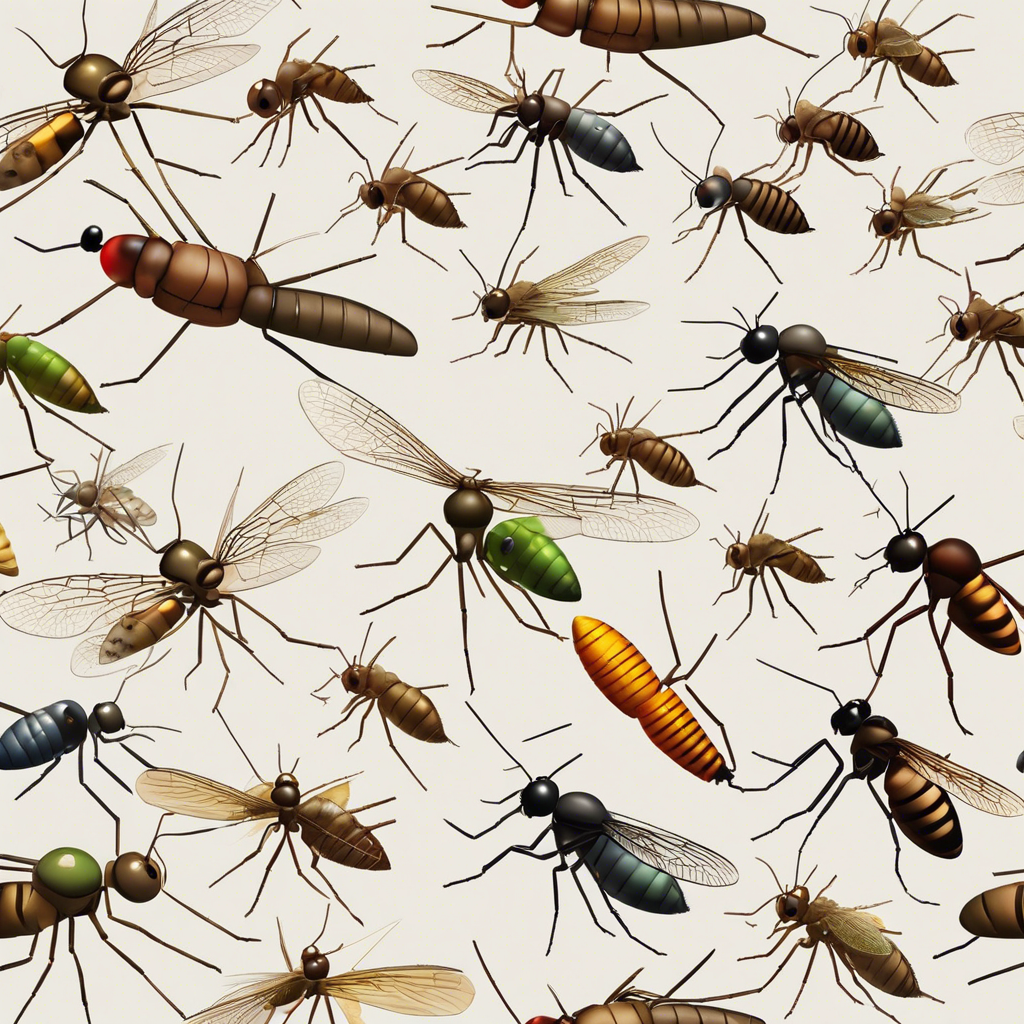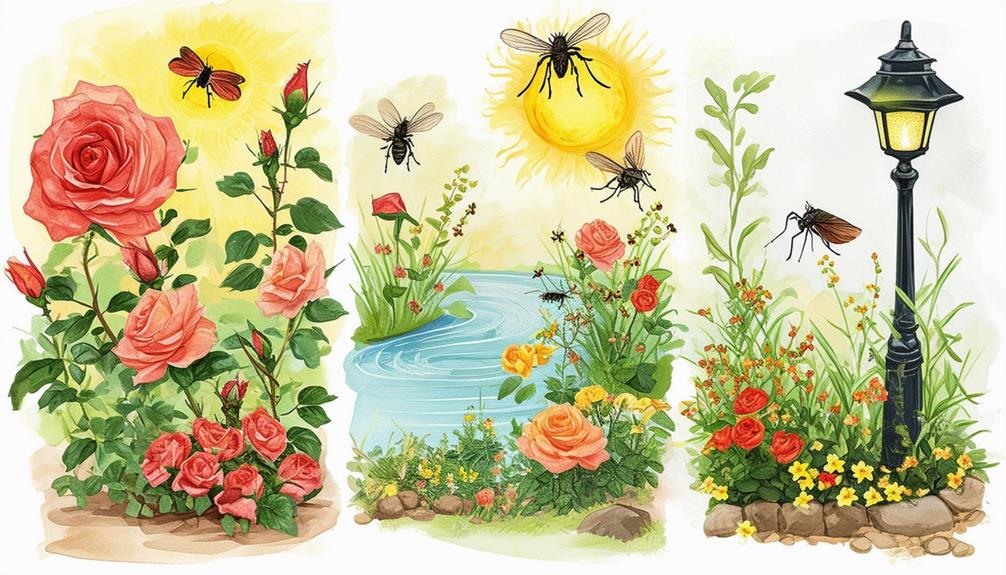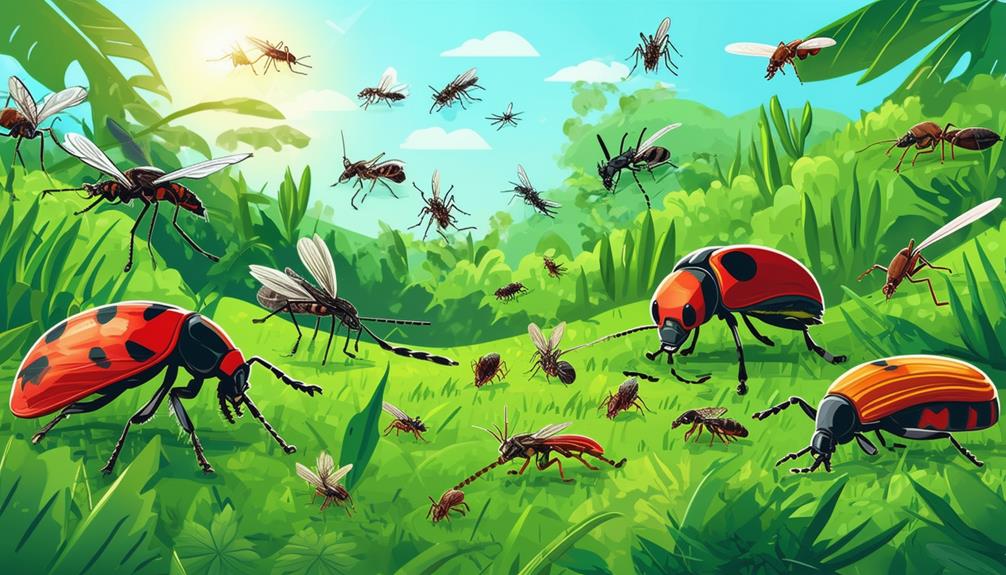You must comprehend the mosquito life cycle to combat this disease-spreading foe effectively. From egg to adult, each stage provides important insights for control. Eggs, influenced by environmental conditions, can survive in various habitats. Larvae molt, utilizing snorkel-like siphons for respiration. Pupae metamorphose, requiring specific control strategies. Adult females needing blood meals to reproduce. Their lifespan fluctuates based on environmental factors. Winter adaptations and temperature impacts are key factors affecting their lifecycle. Gaining a deeper understanding of these stages is essential in developing successful pest management approaches.
Key Takeaways
- Mosquito life cycle stages include egg, larva, pupa, and adult with distinct characteristics.
- Larval growth is crucial for controlling mosquito populations through targeted larvicide applications.
- Pupal transformation involves metamorphosis and resistance to traditional larvicides, requiring pupicides like mineral oil.
- Female adult mosquitoes need a blood meal for egg-laying, influencing their lifespan and reproductive capabilities.
- Understanding temperature effects, winter adaptations, and environmental factors is essential for effective mosquito control and disease prevention.
Mosquito Life Cycle Overview
In the lifecycle of mosquitoes, the progression through four distinct stages – egg, larva, pupa, and adult – is essential to understanding their development and behavior.
Mosquitoes begin as eggs laid in water, progressing to larvae, which are aquatic and undergo several molts. Larvae have specialized structures like snorkel-like siphons to breathe.
The next stage is the pupae, where mosquitoes don’t feed but undergo metamorphosis. Finally, they emerge as adults, ready to fly and reproduce.
Only female adults require a blood meal to lay eggs, making them the ones responsible for blood-feeding. Understanding each stage is critical for effective mosquito control strategies.
By targeting breeding sites for larvae, such as standing water, and implementing measures to prevent adult mosquitoes from thriving, like using insecticides or biological control methods, you can significantly reduce mosquito populations and the diseases they may transmit.
Mastering the mosquito life cycle is key to managing these pesky insects and minimizing their impact on human health.
Egg Stage Development
When a female mosquito lays her eggs in suitable environments, such as water or damp soil, specific factors come into play for successful hatching. Environmental conditions like temperature and moisture play vital roles in the duration of egg incubation.
Understanding the intricacies of the egg hatching process sheds light on the significance of these environmental factors in the early stages of mosquito development.
Egg Hatching Process
During the egg hatching process of mosquitoes, the aquatic environment plays a critical role in triggering the development from eggs to larvae. Female mosquitoes carefully select suitable locations for egg-laying, often opting for water sources like ponds, marshes, or containers.
The eggs, laid individually or in rafts, are designed to withstand dry conditions until submerged in water, where they can hatch. This strategic adaptation allows mosquito eggs to survive unfavorable environmental conditions. Once immersed, the hatching process begins, leading to larva development.
Understanding this process is fundamental for effective mosquito control measures. By targeting areas where mosquito eggs are likely to hatch, such as standing water, interventions can disrupt the life cycle of mosquitoes and reduce their population.
Environmental Factors Affecting
Considering the intricate interplay between various environmental factors, the development of mosquito eggs progresses in a delicately balanced ecosystem.
- Mosquito eggs are highly adaptable, being laid in rafts or on land likely to flood, some even capable of surviving dry conditions.
- The hatching of eggs in water creates a suitable environment for their development.
- Environmental elements such as temperature, humidity, and food availability play a critical role in influencing the growth of mosquito eggs.
- Female mosquitoes strategically deposit their eggs on or near water, soil, or at the base of plants to guarantee the survival of their offspring.
Understanding these environmental factors is essential for effective mosquito control and prevention strategies.
Duration of Incubation
The development of mosquito eggs undergoes an incubation period lasting typically 2-3 days in water. This duration is influenced by environmental factors such as temperature and humidity. Warmer temperatures generally shorten the incubation time, while humidity levels can also play a role in determining how quickly the eggs hatch.
Female mosquitoes carefully choose their egg-laying sites to provide the best conditions for their offspring’s survival. Eggs are typically laid in batches ranging from 100 to 300, ensuring a higher chance of successful hatching.
Additionally, mosquito eggs exhibit remarkable resistance to drying out and can remain viable in dry conditions until they come into contact with water, triggering the hatching process.
Larval Growth Process
In the growth process of mosquito larvae, molting is a critical biological activity that occurs several times. As larvae, also known as wigglers, progress through their development, they undergo multiple molting stages shedding their exoskeletons to accommodate their increasing size.
During this larval stage, they breathe through snorkel-like siphons protruding from the water’s surface or horizontally while immersed. This breathing mechanism allows them to extract oxygen from the air, essential for their growth and survival.
Additionally, the larval stage plays an important role in controlling mosquito populations, making it a prime target for larvicide applications. These applications, whether applied on land or aerially, effectively reduce adult mosquito populations, mitigating the impact of mosquitoes on public health.
- Mosquito larvae molt multiple times during their growth process.
- Larvae breathe through snorkel-like siphons or horizontally while in water.
- The larval stage is vital for controlling mosquito populations through targeted treatments.
- Larvicide applications, whether land-based or aerial, are effective in reducing adult mosquito populations.
Pupal Transformation Stage
During the pupal transformation stage, mosquitoes undergo a significant physiological metamorphosis important for their development into adults. Pupal mosquitoes pose a challenge for control methods as they’re biologically distinct and resistant to traditional larvicides, necessitating specific approaches for effective mosquito management.
Identifying pupal mosquitoes is important for implementing targeted control strategies. Pupicides, such as mineral oil, are utilized to suffocate pupae on water surfaces, preventing their emergence as adult mosquitoes. However, it’s essential to exercise caution when using pupicides to minimize unintended harm to non-target organisms in the ecosystem.
Timing larval inspections plays an important role in preventing pupae from completing their development and emerging as adult mosquitoes, contributing to overall mosquito population control efforts. Understanding the pupal transformation stage and employing appropriate control measures are essential components of thorough mosquito management strategies.
Adult Mosquito Characteristics
Adult mosquitoes exhibit distinct characteristics that play crucial roles in their reproductive and survival strategies. Female mosquitoes, the ones responsible for blood-feeding, are key to egg-laying, as they require a blood meal to develop and lay eggs.
Once emerging as adults, they take flight after their body parts have hardened, ready to seek out their next blood meal. The lifespan of an adult mosquito can range from a mere 4 days to a more extended period of 2-4 weeks, a duration influenced by both the mosquito species and the prevailing environmental conditions.
In the American southeast alone, a region harboring 64 different mosquito species, about half of them have adapted their feeding habits to target mammals, including humans. This specialization in feeding preferences contributes greatly to the survival and proliferation of these mosquito populations.
Impact of Environmental Factors
Environmental factors greatly influence the development and life cycle progression of mosquitoes, with temperature, humidity, and food availability playing pivotal roles.
Temperature has a significant impact on mosquito life cycle timing, with warmer temperatures expediting their development. Mosquitoes thrive in warmer weather, leading to faster completion of their life cycle stages during spring and summer. Additionally, higher temperatures can make mosquitoes more resistant to insecticides, posing challenges for pest control efforts. Conversely, lower temperatures can induce torpor and hibernation in mosquitoes, slowing down their life cycle progression.
Some mosquito species have evolved winter-hardy eggs that remain dormant until warmer spring weather triggers their hatching, ensuring their survival through the colder months.
Understanding how environmental factors such as temperature influence mosquito development is essential for effective pest management strategies and controlling mosquito-borne diseases.
Frequently Asked Questions
What Is the Life Cycle of Mosquito Theory?
You want to know the life cycle of a mosquito. It starts in breeding grounds, then larvae develop, followed by pupa transformation. Adults emerge once their body parts harden. Females feed on blood for reproduction.
What Is the Natural Enemy of the Mosquito?
Dragonflies, with their predatory nature, serve as natural enemies to mosquitoes. They consume mosquitoes at different life stages, effectively controlling mosquito populations. Through biological control, dragonflies play an essential role in maintaining ecological balance.
At What Stage in the Life Cycle of the Mosquito They Are Considered Harmful?
Do you know at what stage in the life cycle of the mosquito they become harmful? Female mosquitoes in the adult stage are considered harmful due to their behavior of biting to feed on blood, leading to disease transmission and impacting humans.
How Can We Break the Life Cycle of the Mosquito?
To break the mosquito life cycle, implement prevention methods like eliminating breeding grounds. This disrupts the reproduction cycle, reducing environmental impact and disease transmission. Control strategies, such as larval inspections and pupicides, are essential for effective management.





